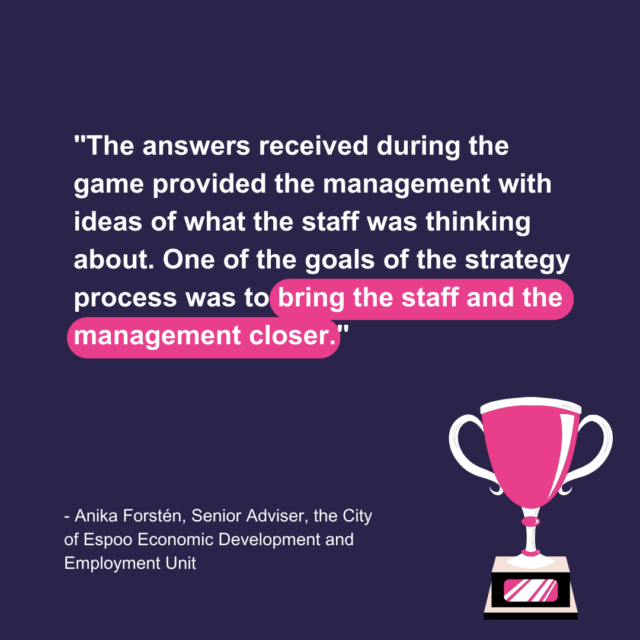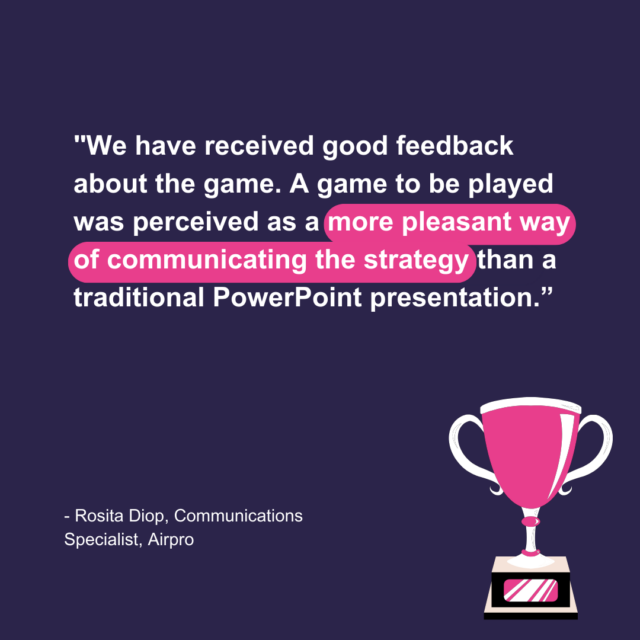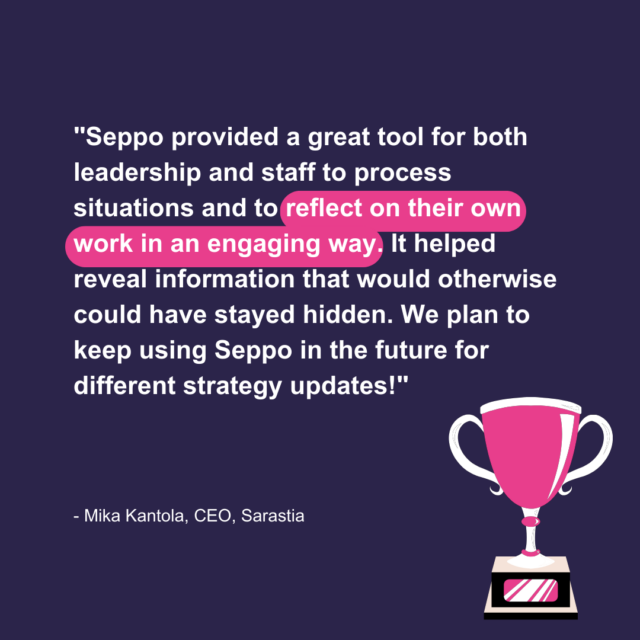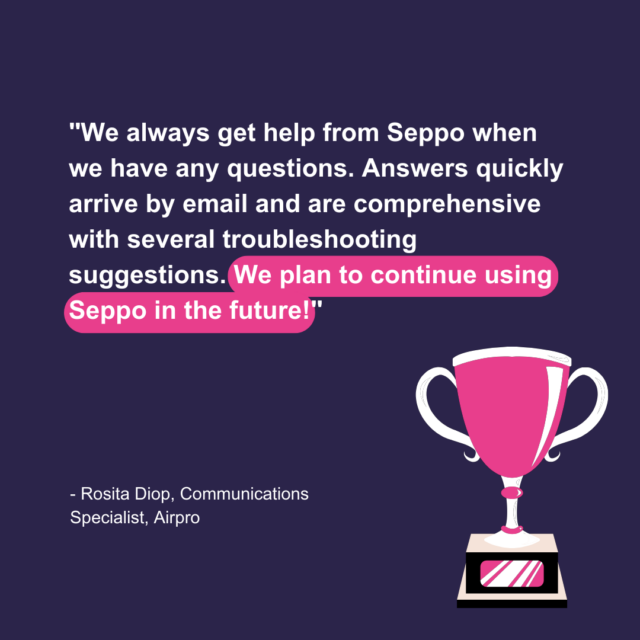5 Stages of Strategy Implementation and How to Gamify Them
5 Stages of Strategy Implementation and How to Gamify Them
Ever made a New Year’s resolution only to watch it fizzle out? Who hasn’t?
But what happens when organisations fail to follow through on their “resolutions”? When organisational strategies fail, a shocking 67%* of the time, the stakes can quickly become dire.
Strategic implementation is crucial to an organisation’s health, but it’s not the most glamorous job in the world. And it’s only made more complex by the usual challenges of implementing strategy*: employee resistance, unclear goals, lack of alignment and poor communication.
But when you pair strategy implementation with an innovative tool like gamification, something interesting happens. Strategy becomes…fun?
We know how this sounds. But at Seppo, we’ve helped make this possible for our customers. And in this blog post, we’ll show you how your organisation could gamify your strategy implementation too—all five stages of it!
What is Strategy Implementation?
Strategy implementation is the process of developing and executing strategies to make sure an organisation reaches its objectives. It covers all the systematic steps you need to take to move your organisation closer to its targets: from brainstorming ideas to creating clear plans, to taking tangible and measurable actions.
Organisational strategy implementation is usually broken down into five stages:
- Planning the Strategy
- Creating the Strategy
- Communicating the Strategy
- Executing the Strategy
- Evaluating and Adapting the Strategy
Sounds simple enough, right?
When done well, strategy implementation unifies the efforts of an entire organisation—all its employees, teams and departments—to achieve important milestones together. And yet, most organisations struggle to get it right. Only 2%* of organisational leaders feel confident about achieving 80–100% of their strategic objectives.
We believe that outdated strategic implementation tools, methods, and resources are to blame.
So here’s a crazy idea: why not gamify strategy implementation instead?
Can You Gamify Strategy Implementation?
Absolutely!
Picture this: Your next strategy initiative starts with an exciting game experience that is the talk of the organisation, turns every employee into a player and transforms strategy into the ultimate quest. But gamification also goes beyond adding an element of fun. It’s a research-backed*, strategic approach that helps you overcome challenges at every stage of strategy implementation, offering a fun and memorable solution that leaves a lasting impact.
Your organisation can choose to follow the familiar path and face the same roadblocks that plague the strategy initiatives of others. Or gamification could become your organisation’s secret to strategy success by:
- Boosting Engagement: Gamification makes strategy implementation more fun and engaging by turning tasks into challenges and milestones into achievements.
- Driving Collaboration: It encourages teamwork and collaboration as employees work together towards common goals, fostering a sense of camaraderie.
- Increasing Accountability: By monitoring progress, measuring results, and rewarding achievements, gamification encourages employees to take responsibility for their role in executing strategies.
- Enhancing Learning: The use of gamification enhances learning and skill development through interactive and enjoyable experiences.
Organisations like Airpro, the City of Espoo and Sarastia have successfully gamified various stages of their strategy implementation with Seppo and have seen remarkable results.
Find out more about this in the section below!
Read: How Corporate Gamification Engages and Motivates Employees
How Do You Gamify a Strategy?
The process of gamifying an organisational strategy involves integrating game elements to increase employee engagement and make it more enjoyable. Here is a breakdown of the key steps:
- Start by identifying the key stages of strategy implementation: planning, creating, communicating, executing, and evaluating.
- Then, incorporate game mechanics like challenges, rewards, leaderboards, and competition into each stage.
- Use interactive tools, such as gamified brainstorming sessions and strategy communication games, to encourage collaboration and participation.
- Provide feedback and recognise achievements to boost motivation.
- Measure and evaluate strategies to make quick adjustments when needed.
When you add gamification, the entire process of strategy implementation becomes a fun adventure that gets employees excited, encourages teamwork, and helps achieve organisational goals.
How to Gamify All 5 Stages of Strategy Implementation
Now, let’s take a closer look at the challenges you face at every single stage of your strategy implementation journey—and how gamification can help you tackle them while turning organisational goals into adventures!
Planning the Strategy
Making use of a strategy brainstorming game that taps into the collective wisdom of your teams and employees can make all the difference at this early stage. You get more than just a treasure trove of ideas—you also get a workforce that is enthusiastic and committed to making them a reality. This can be a game-changer when you consider that 37%* of leaders find gaining support across their organisation to be their toughest strategy implementation challenge.
Here’s why gamification is a great partner for the strategic planning stage:
- According to research*, gamification is a highly effective strategy for fostering collaboration and engagement, which makes it an ideal tool for brainstorming.
- You can make the mundane process of data gathering and analysis more engaging by infusing it with elements of play, turning it into quests and challenges.
- By incorporating interactive surveys and quizzes, you can encourage your employees to actively participate and gain valuable insights into their preferences.
Consider the City of Espoo, one of our customers. With their 50th anniversary coming up, they turned the upcoming strategic planning session into a game. The entire process brought immense joy to the celebration and sparked countless ideas for a new city story during the brainstorming session.
Here’s what they said about the experience:

Read more: How the City of Espoo Gamified their Strategy Implementation
Creating the Strategy
With brilliant ideas in tow, it’s now time to formulate the strategy. This foundation will not only guide the company’s future strategy, but possibly decide its entire future. No pressure, right?
Strategy creation can often be the most anxiety-inducing part of the entire strategy implementation process. You need to gather input and collaboration across departments and levels in the organisation, which is harder than herding cats. And let’s face it, traditional strategy sessions don’t exactly inspire innovative solutions, especially when employees feel disengaged and disconnected* from the whole process.
Here’s how gamification helps tackle these challenges:
-
- Collaboration issues: Gamified strategy sessions offer much-needed opportunities for employees across different levels and departments to share ideas and engage in interactive communication, effectively breaking down silos and promoting collaboration.
- Difficulties with innovation: Gamified strategy sessions provide a safe virtual environment for employees to explore new ideas and experiment with approaches without fear of judgement or failure.
- Lack of engagement: When gamification solutions are implemented in workplace training programs, as many as 85% of employees show increased engagement*. Need we say more?
Communicating the Strategy
Did you know that an astonishing 95%* of employees are unaware of or don’t understand their organisation’s strategy?
This is the big flaw in strategy communication. Even with all the hard work, sweat, and tears poured into them, most organisational strategies fail to capture employees’ attention or make a lasting impression beyond the first round of communication. You know the main culprits well: emails, PDFs, PPTs—traditional, static communication methods that are simply not designed to help complex information stick around in long-term memory.
So, how does gamification help?
- Engagement and memorability: Games inject interactivity and excitement into your strategy communications, making sure they’re not just more engaging but also more memorable*.
- Comprehension: Gamification simplifies complex strategies by presenting them in bite-sized chunks of information and interactive formats, making them easier to understand and recall.
- Participation: Most strategy communications are passive and do not encourage employee interaction. However, in gamified strategy communications, active participation is not only encouraged but also promoted through challenges, quizzes, and competitions.
Consider Airpro, a leading air travel services company. In a bold move, they ditched their usual strategy communication PowerPoint presentations in favour of a cutting-edge strategy game created by Seppo. With its impressive animations, immersive videos, and stimulating interactive tasks, the game revolutionised how employees absorbed and grasped the company’s strategic vision.

Read more: How Airpro Used Seppo Games to Communicate Strategy
Executing the Strategy
Talk is cheap when it comes to strategy. The real challenge is putting it into action, and that’s where most organisations trip up. While 80% of organisation leaders believe their company is skilled in strategy formulation, only 44%* feel confident in their strategy execution abilities.
Sadly, evidence supports this: poor execution leads to the failure of about 67%* of well-formulated strategies. And it isn’t hard to guess why. The same challenges we’ve discussed in strategy communication also arise in this case. On top of that, as tasks become repetitive, organisations have to tackle employee resistance, lack of motivation, and teams struggling to stay aligned on common goals.
But we’ve seen strategy games break this pattern. Here’s how:
-
- Resistance: As the novelty of strategy execution tasks wears off, resistance sets in and employee productivity declines. But if gamified elements are added to the same tasks, employees can find them more rewarding due to the fun, competition, and challenge involved.
- Lack of Motivation: Game mechanics such as points, levels, and badges help keep employees motivated* throughout the execution phase.
- Difficulty in Aligning Teams: How does gamification keep teams from working on conflicting goals? By creating a virtual space where employees from different teams are rewarded and incentivised to work together towards common objectives—objectives that align with the company’s strategic priorities. It’s also a great opportunity to use leaderboards and team-based competitions to promote camaraderie and healthy competition.
Look at Sarastia, a Finnish financial and HR company that achieved remarkable success by adopting a gamified approach to its strategy execution. With Seppo’s help, Sarastia employees found themselves enthusiastically working towards tackling strategic goals, honing their teamwork skills, and celebrating victories along the way.

Not only did Sarastia achieve their strategic objectives but they also fostered a culture of excitement and collaboration among their teams. Who knew strategy execution could be this much fun?
Evaluating and Adapting the Strategy
Now, the real question is: how can you tell if your strategies are working?
As it turns out, most organisations can’t. 25%* of business leaders say that measuring the implementation of their strategies proves to be the toughest challenge. And a majority of organisations—58%* to be exact—believe that their current systems for tracking strategy performance are lacking.
So what value does gamification offer in this situation? Let’s see:
- Data collection: When you use gamification to plan, create, communicate, and/or execute strategy, guess what reward awaits you at the end? A goldmine of data on employee interactions and performance. With gamified surveys, quizzes, and tasks, you can gather a substantial amount of valuable data with a higher response rate and greater accuracy compared to traditional methods.
- Data analysis: By analysing this data, you uncover valuable insights into employee preferences, identifying both their strengths and areas for improvement. This knowledge can then be used to evaluate strategy performance, adapt quickly, and make informed tweaks and decisions.
- Real-time Feedback: Some gamification platforms come built-in with a feature for real-time feedback, with which organisations can instantly start measuring the effectiveness of their strategies. Thanks to this immediate feedback loop, decision-making becomes faster, and adjustments can be made promptly.
In this challenging phase, a reliable gamification partner can be a lifeline, providing constant support and motivation to keep pushing forward.
Like we do with all our customers, we were delighted to provide Airpro with immediate technical assistance whenever they required it. Our partnership has led to the development of several corporate games that Airpro employees not only love but also thoroughly enjoy!

Onboarding to Change Management: How Seppo Solves Organisational Challenges with Fun Corporate Games
Level Up Your Strategy Game
As we wrap up our journey through gamifying every stage of strategy implementation, let’s reflect on the transformative power of this approach. Strategy implementation isn’t just about making plans, it’s about turning aspirations into actionable steps that drive organisational success.
By gamifying one or all of the stages in implementing strategy—planning, creating, communicating, executing, and evaluating—your organisation can unlock untapped potential, foster collaboration, and inspire a sense of purpose among employees.
From the City of Espoo’s innovative brainstorming sessions to Airpro’s engaging strategy communication, the success stories speak volumes. Gamification isn’t just a buzzword—it’s a proven strategy for navigating the complexities of modern organisational strategy challenges.
So as you think about your next strategic move, remember the power of play.
Don’t let outdated methods hold you back. Book a demo for Seppo’s gamification platform and transform how your organisation implements strategy!
Sources:
-
Why Strategies Fail? A Review on Strategy Implementation – Research Gate
-
Strategy Implementation Survey Results 2012 – Bridges Business Consultancy
-
The Gamification of Work : The Use of Games in the Workplace – Research Gate
-
50+ Eye-Opening Strategic Planning Statistics [2022] – ClearPoint Strategy
-
Social Collaboration and Gamification – Research Gate
-
Employee Disengagement: A Fatal Consequence to Organization and Its Ameliorative Measures – Research Gate
-
Executives Fail to Execute Strategy Because They’re Too Internally Focused – Harvard Business Review
-
The Office of Strategy Management – Harvard Business Review
-
Increasing Knowledge Retention Through Gamified Workshops – Scholar Space
-
The Effect of Gamification on Motivation and Engagement – Emerald Insight
-
The 5 Pillars of Successful Strategy Execution – Gartner